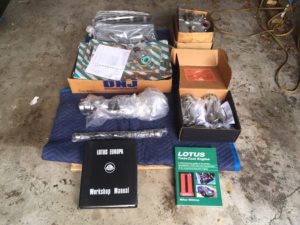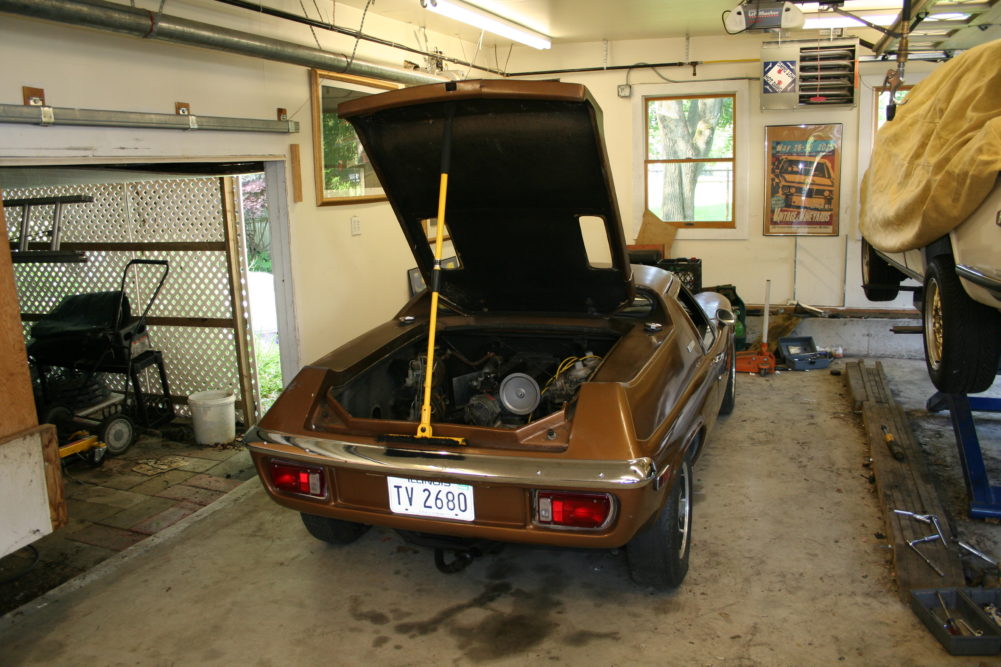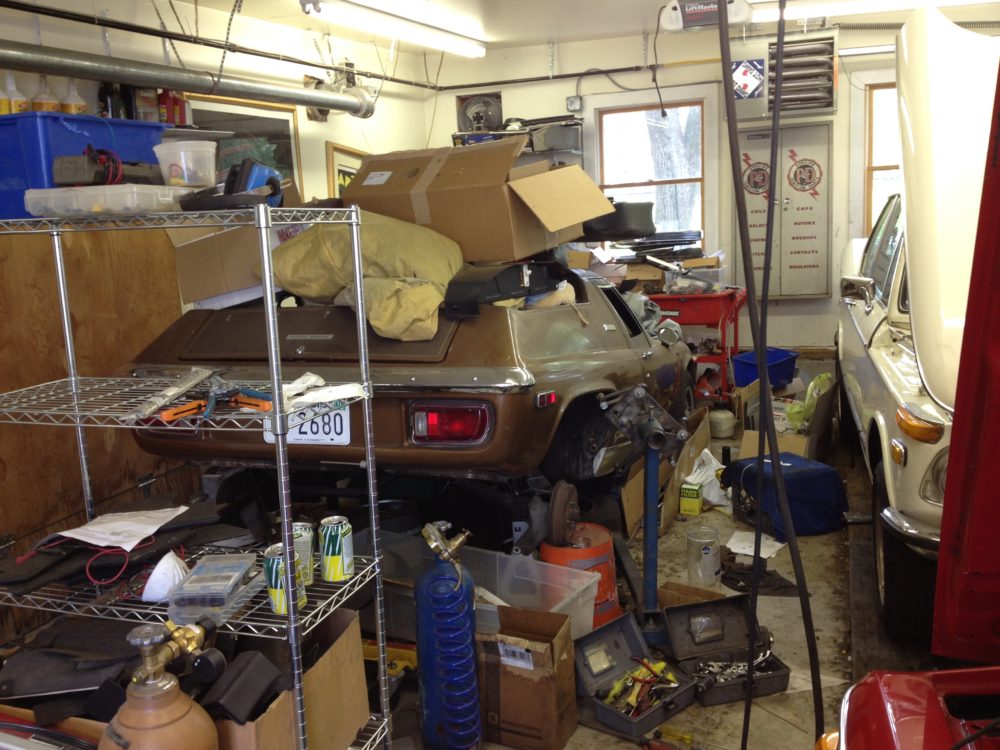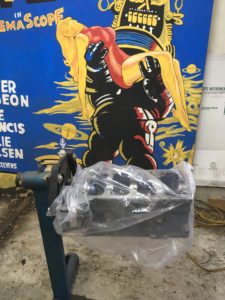With the new gas tank, the differential swap, and the shift-bushing repair on the ’79 Euro 635CSi, the car is ostensibly ready for a run in May down to the Vintage. But with the driving season delayed, with winter still apparently on the Nor’Easter Of The Week plan even as the calendar rounded the corner into spring, I wondered what project I’d be working on next.
And then a bolt came from the blue. The machine shop that’s had my Lotus bottom end for four-and-a-half years called and said that it was ready.
I need to take a giant step back here, as I haven’t written much in this space about the Lowtush. (Imagine Sean Connery saying it. Say it to yourself out loud that way—go ahead, it’s funny.) In June 2013, shortly after my first book was published, I wanted to mark the occasion and buy myself a present. I scratched a lifelong itch and bought a 1974 Lotus Europa Twin-Cam Special—which hadn’t run since 1979. On the one hand, it was deader than Grover Cleveland, it had a seized engine, it was in Chicago; I knew nothing about Europas, and had never even driven one.
On the other hand, it had only 20,000 original miles on it; the last time I bought an unfamiliar car, it was the ’82 Porsche 911SC, and that worked out great; it cost me the almost-reasonable-sounding sum of $6,000; and CCA member Ben Thongsai, who owns a Lotus Elan, looked at it for me and said I could do worse. (Actually, when I authorized him to negotiate on my behalf, what he said was, “Congratulations, you’ve bought a little brown thing.”)
Long story as short as possible, I had the car shipped from Chicago, rolled it into my garage, and in a few feverish days, yanked the drivetrain and tore down the seized engine. I freed the stuck piston, but found that the cylinders were sleeved, so something big and bad had happened to the motor in those 20,000 miles (I didn’t know yet that Lotus stands for Lots Of Trouble, Usually Serious).
I took the disassembled engine to a local Lotus engine god, who cleaned and crack-checked the major components and sized things up. He said that the sleeves were 0.060″ thick; the available first-oversize pistons were 0.020″ larger than the original ones, but advised that you can’t bore sleeves by that much. The most cost-effective path appeared to be to order custom pistons, but the Lotus god wouldn’t quote me a price, saying that this was a bad way to build the kind of vintage-racing motors he specializes in.
Shortly after that, I spoke with someone who’d paid the Lotus god twelve grand to rebuild his engine.
I panicked, paid the god for his work to date, pulled the engine out of his shop, and took it to a more conventional machine shop not far from my house. I explained that I wanted a street motor, not a vintage-racing engine, and that I’d do the reassembly. The machinist gave me estimates in the more palatable $3,000–$4,000 range. He got the head done, but for a number of reasons, including my career change and my resultant inability to aim the firehose of spending at every car I owned, the Lotus’ bottom end languished in the machine shop for years.
Then, last spring, I had something of a sign: I was on some traffic-y section of I-81, driving Louie the 2002tii down to the Vintage, when one of my traveling companions called on the cell and said the last nine words I ever expected to hear: “Hey, Rob, there’s a red Lotus Europa up ahead.” Sure enough, when the traffic cleared, there was the unmistakable silhouette of a Europa Twin-Cam like mine, gossamer-like and impossibly low and angular; it was thrilling to see one in the wild. (And because it’s a very small world, I’m now Facebook friends with the owner.)

When was the last time you saw a Europa in the wild? Pretty arresting, no?
I resolved that when I got home from the Vintage, I’d pay a visit to machine shop and re-start the project—and I did. No harm no foul, I said, my fault for the lack of action, but let’s front-burner this thing.
So, in a visit to the machine shop strategically timed between days when my garage door become inaccessible due to piles from the snowblower, I picked up the lower end parts and disgorged them into the garage. To badly paraphrase Mister Scott in Star Trek IV: The Voyage Home, “Hack-ton, there be Lotus engine parts here!”

The freshly-machined block, crank, jackshaft, and other lower-end parts are now in one place.
This Lotus project is unlike my normal BMW projects in so many ways. First, it’s a freaking Lotus. Despite having owned it for nearly five years, it’s a car I’m unfamiliar with. It’s a fiberglass body on a metal backbone and weighs 1,500 pounds soaking wet. It’s a combination of English and metric fasteners. Most have UNC threads. The electricals aren’t Bosch. (Hold the Lucas jokes, please. Been there, flickered that.)
Second, I fundamentally misjudged the project’s expense and risk. If I buy a 2002 that needs an engine, I know that can find one for $300 with no provenance or guarantee, or find one for $800 where I can look the seller in the eye and have him or her say, “Yup, pulled it out of a parts car myself, it’s a runner, not a burner,” or find one that’s been freshly rebuilt for—well, more—but I also know that “more” tops out at about four grand.
In contrast, Lotus Ford Twin-Cam (or “Twinc”) engines were not made in the kind of volume that 2002 M10 engines were. You basically don’t find runners at all, and fresh rebuilds easily top ten grand.
Third, I didn’t know, when I bought the car, that yanking the drivetrain would turn the car into a beached whale. To save weight, Europas have no rear subframe; the rear lower control arms attach to the bottom of the transaxle, using it as a stressed member. This means that with the transaxle out, there’s nothing affixing the camber of the rear wheels, and they flop in the breeze. Not only won’t the car roll, it won’t even support itself. So the car has not only been dead in my garage for nearly five years, it’s been immobile on jack stands.
Fourth, although I know myself and my limits very well, and for that reason I don’t really “restore” anything—too big a project, too much time, too much money—I didn’t realize that the second and third points above would prevent this from being the kind of toss-in-a-motor-sort-it-out-and-get-it-running projects I’m used to.
When I back-burnered the motor, I also took a wrench to spending of any kind. Add to that the natural entropy that envelopes anything in my immediate vicinity. So, yes, it was my fault that the Lotus sat for nearly five years, but in those five years it went from this:

The freshly-delivered Europa
To this:

That’s a spare 2002 back seat (among other things) on the Lotus’ engine deck. So it IS serving a 2002-related purpose.
Oddly enough, the fact that the car was a beached whale may have saved it. Think about it: You see engine-less cars advertised on Craigstlist all the time as “rollers.” Someone begins an engine rebuild or a restoration, gets in over their head, and bails out. It’s not a big deal to roll the car out of the garage and onto a flatbed. With the Lowtush (still funny, right?) not having the ability to roll, it may have been protected by its own inertia, which, considering it’s a 1,500-lb car, is something of a miracle.
This project is different in another important way as well. Most BMW parts are click-and-buy. If I’m working on a car and find I need a part, I’ll usually walk up to the laptop computer I have in the garage, check prices on, say, BavAuto, FCPEuro, BluntTech, and ECS Tuning (add GetBMWParts, Pelican, AutohausAZ, Amazon, eBay, and even Rockauto if I’m really looking to price-shop the full range from OEM to possibly junk), and hit “buy” without even leaving the garage. In contrast, the two domestic Lotus parts houses, Dave Bean in California and RD Enterprises in Pennsylvania, are both throwbacks; neither has an online ordering system. You have to call or e-mail them with a request for quote, then call or e-mail a second time to pull the trigger on it. The British Lotus houses Burton Power and QED Motorsports have very thorough websites where you can click and order, but overseas shipping ain’t cheap.
I now have that beautiful clean block on my engine stand. Since I know nothing, I’m triangulating between the shop manual, Miles Wilkens’ Lotus Twin-Cam Engine book, and an enthusiast forum before I take the first step.

It looks like Forbidden Planet‘s Robby the Robot is going to lay the girl into my Lotus block in place of the crankshaft.
Considering the glacial pace of knowledge-gathering and parts-ordering, I figure, with other things going on, that it’ll probably be three months before the engine is fully assembled, another three before it and the drivetrain are back in the car, and probably six months of general sorting of the cooling, fuel delivery, brakes, suspension, and electrical system before it backs out of the garage under power. That puts us into next summer. In that time, I could’ve bought, resurrected, and sold several 2002s.
But, hey, after 4½ years, the Lowtush (go ahead) is front-burnered. And that alone is worth celebrating. Whatever pace the project unfolds at is fine. I’m sure it will get bumped time and time again by more urgent BMW-related business.—Rob Siegel
Got a question for Rob Siegel, the Hack Mechanic? You can find him in the BMW CCA Forums here!
Rob’s new book, Ran When Parked: How I Resurrected a Decade-Dead 1972 BMW 2002tii and Road-Tripped it a Thousand Miles Back Home, and How You Can, Too, is now available on Amazon. Or you can order personally inscribed copies through Rob’s website: www.robsiegel.com. His new book, Just Needs a Recharge: The Hack MechanicTM Guide to Vintage Air Conditioning, will be out in the spring.





















